

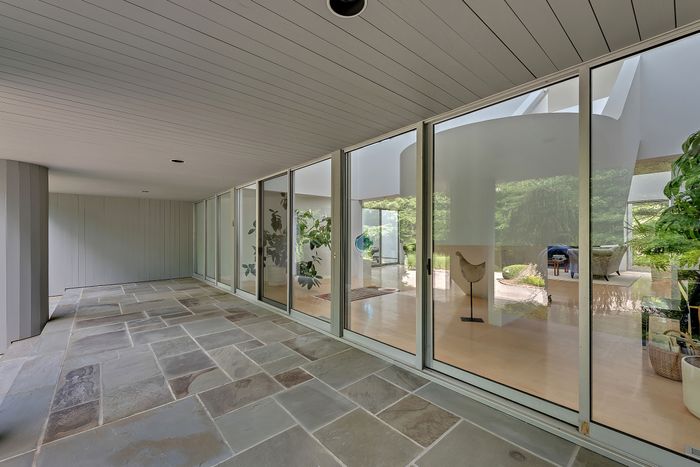

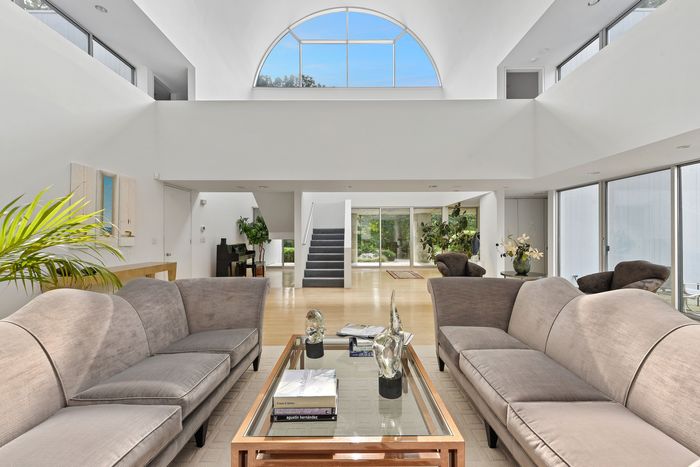

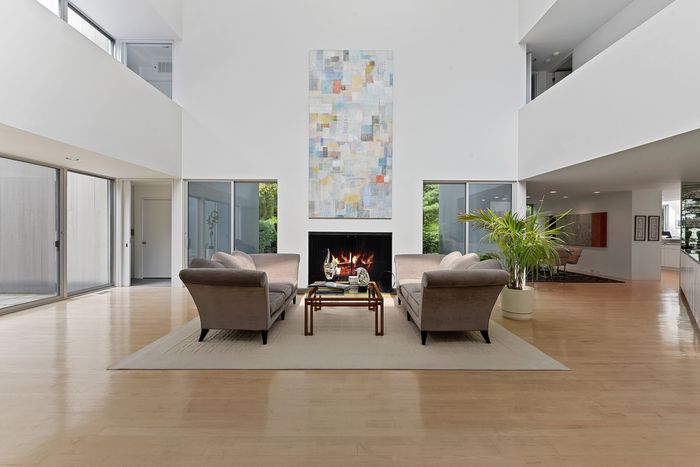
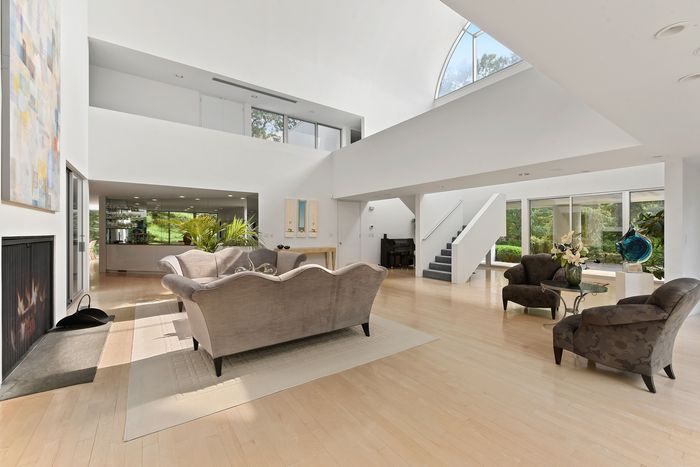

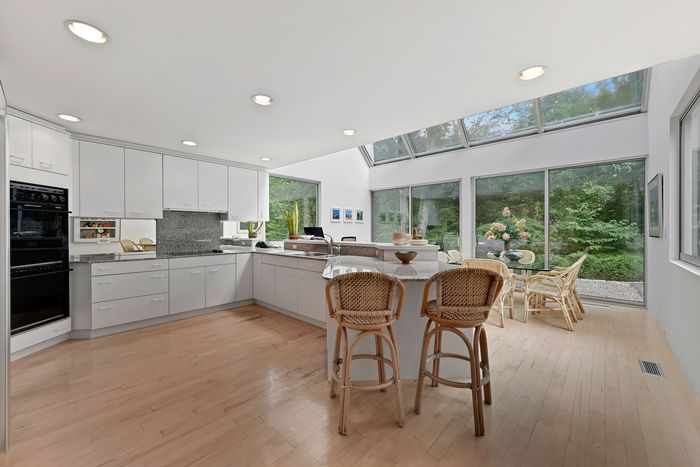

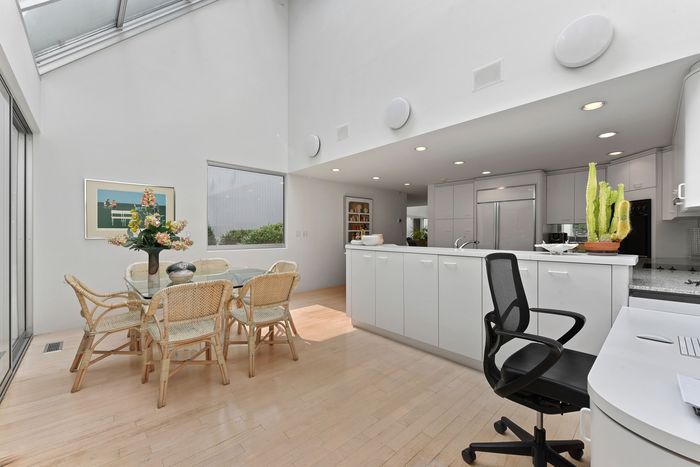

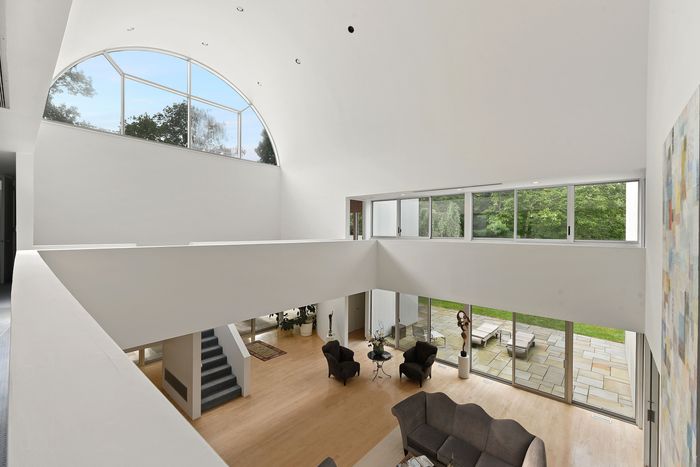
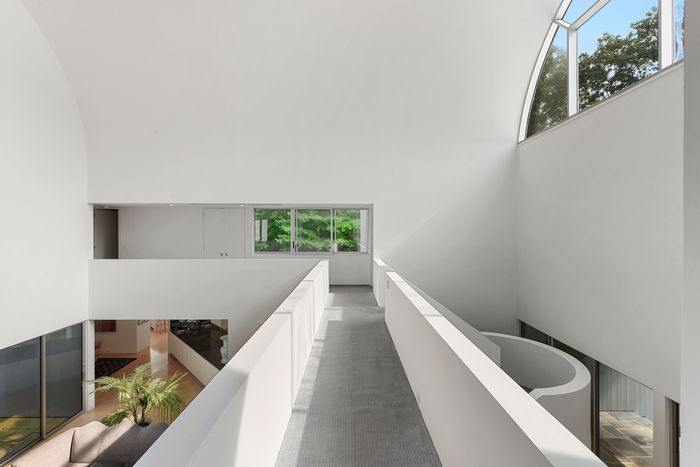

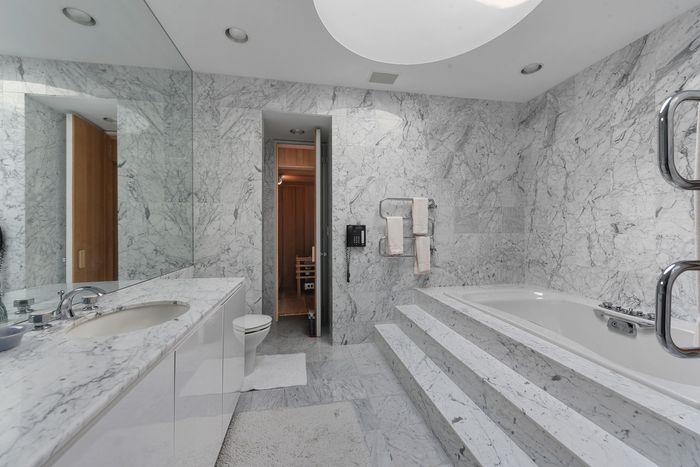
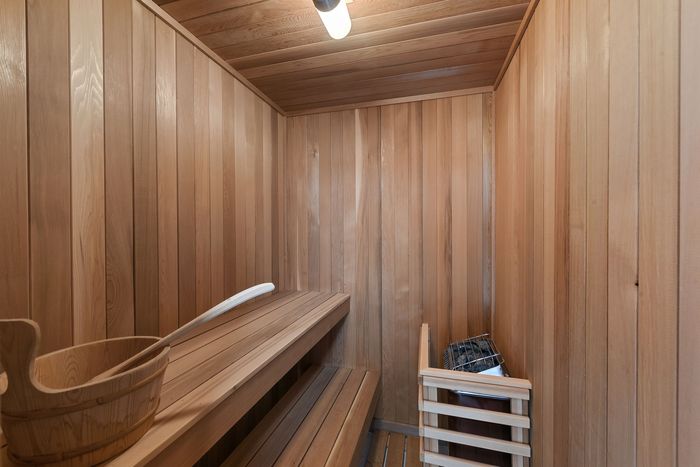

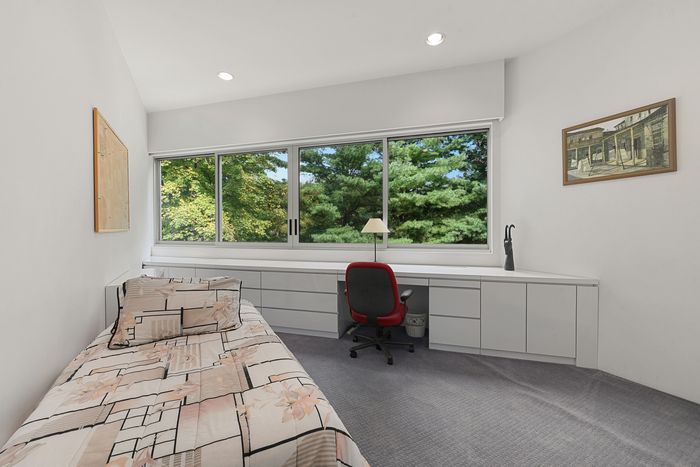
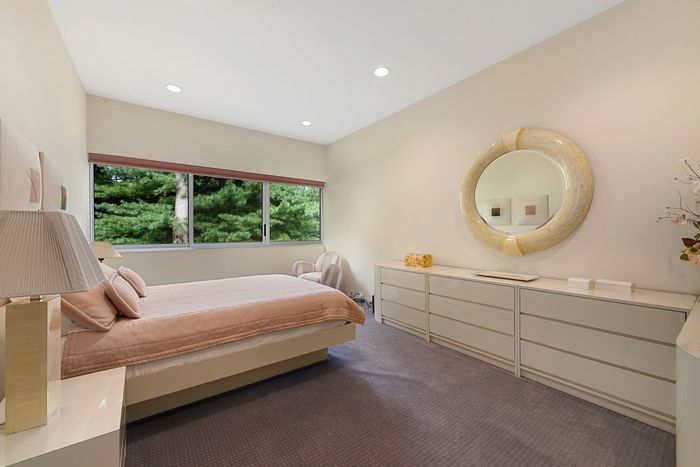

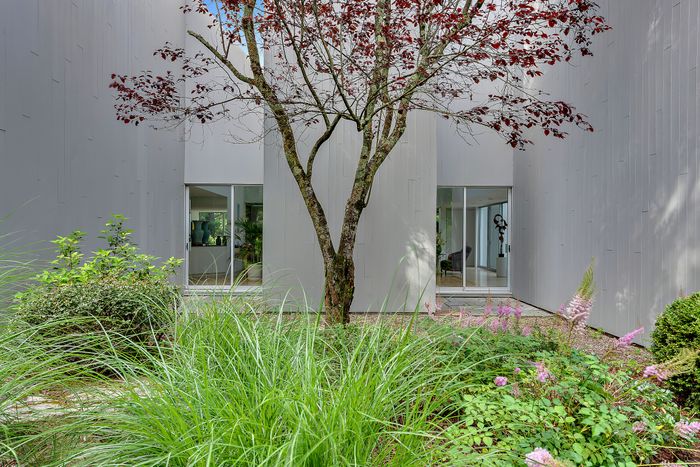

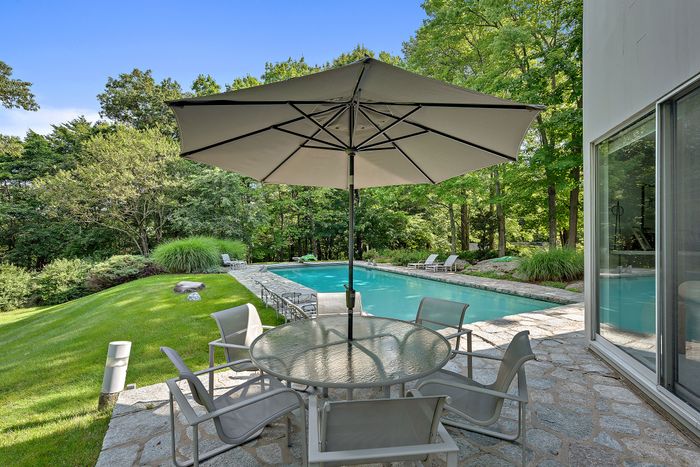



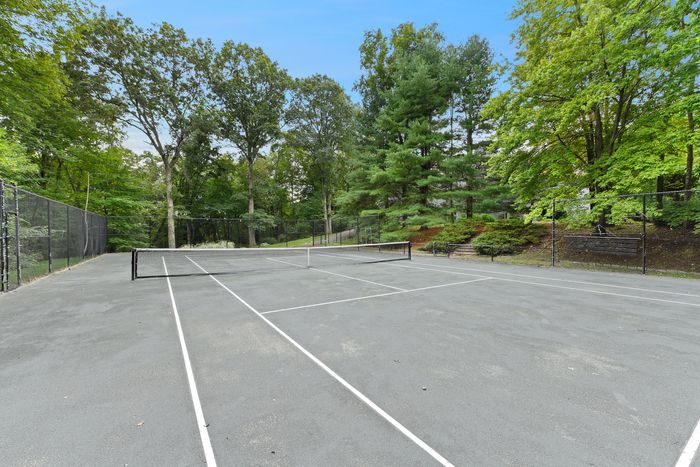

The 1989 Myron Goldfinger home custom-built for the DiSavino family in Chappaqua is on the market for the first time. The architect, who died this summer at the age of 90, was known for turning simple geometric forms into grand, luxurious homes. Photo: Brian Milton/Compass
In 33 years, the DiSavino family never got a trick-or-treater. Their modern, ash-gray home is hidden at the end of a long private drive, obscured from the street by four acres of woods. But remotely, architecture buffs have been ogling photos of their home — one of the blocky, white-and-gray mansions designed in the 1980s and 1990s by the modernist Myron Goldfinger, who died last month at age 90. He is known for turning solid, geometric shapes into monumental mansions for celebrities and executives across Connecticut, New York, and New Jersey, but any story about the architect never fails to single one of them out in particular: a 1981 beach house trashed by partygoers in Martin Scorsese’s The Wolf of Wall Street.
Goldfinger might have hated those headlines; he wanted his homes to be serene, almost spiritual spaces, telling Architectural Digest in 1980 that he sought to achieve “a temple-like quality” through his use of “basic forms” and was also inspired by the minimalist mosques in Tunisia nor he was by Le Corbusier. The DiSavino family tapped him in part because of their admiration for another religious space: the Temple Beth El, which they attended when they moved to the area. Its simple octagonal prayer room was designed by Louis KahnGoldfinger’s mentorand they liked the idea of a home designed by a Kahn disciple. They also told Goldfinger they needed the serenity he and Kahn were known for; they had teenagers. Three daughters aged 18, 13, and 7 each wanted their own space, and the couple wanted privacy, too, said Eileen DiSavino. “The solution was the wings in the house, and Myron came up with that.”
The layout of 319 is inspired by a “fragmented pinwheel,” according to Goldfinger. Like the plastic blades curled around a pinwheel axle, four separate wings fan off from a central great room. The layout allows the separate wings — which hold bedrooms and a home office — to feel remote and private, while the living spaces below helped the family feel connected without feeling watched, says Peter Tripp, a DiSavino son-in-law who happened to study architecture at Goldfinger’s alma mater, the University of Pennsylvania. On visits, Tripp liked how the “pinwheel” allowed anyone in the great room to be aware of a TV playing in the family room or chatter coming from the kitchen, but not see or hear well enough to pry. When everyone comes together in the great room, they stream in from the home’s four corners. “It’s this wonderful, unifying element that happens in the morning and the evening,” Tripp said. “There’s a very nice way that the space is keeping the family together — even when they want to be apart.”
The layout may be unique to Goldfinger homes, but it still has many of his signatures: a 40-foot-high barrel ceiling, a floating hallway that cuts through that quadruple-height space, and walls of floor-to-ceiling windows that frame the landscape. The space is also composed of simple geometric forms: two terraces and a patio are shaped like half circles, and rooms in one wing end on the 45-degree angles of right triangles, giving pointed views. A floating staircase repeats the half-circle motif.
Eileen DiSavino doesn’t remember ever pushing back against any Goldfinger designs, other than insisting on an ensuite bathroom. Her husband, Leonard DiSavino, who died in 2016was “not risk averse,” Tripp said. He was an entrepreneur who was early to the telecom revolution, co-founding a company that put pagers in American pockets. He was so enamored with the house that he visited every day of construction and, when it was done, still kept in touch with Goldfinger for decades. Over 33 years, the DiSavino family tweaked very little — replacing a spiral staircase with an elevator, and doing away with a steam shower (which can be added back). “We very much respected the dignity of what Myron did and sought to maintain it — exterior and interior,” says DiSavino, who remembers exhausting contractors with an insistence on keeping every detail. “We love it, basically.”
Even as her children grew older and started their own lives, the house has continued to serve as a place where they can reconnect. She now has seven grandchildren who have visited almost every holiday and for much of the summer, swimming in the saltwater pool, batting balls in the tennis court, and shouting down from “the bridge,” the family’s affectionate term for that floating hallway. “They were here this summer, and the kids were crying, ‘It’s our last one here.’” she said. “It’s been joyful.”
The DiSavino family has lived here since 1989, and took care to uphold Goldfinger’s original vision, sometimes replacing the simple wooden slats on the exterior with identical materials. Photo: Brian Milton/Compass
The foyer looks out onto the four-acre lot in Chappaqua through an entrance of simple sliding glass doors. Photo: Brian Milton/Compass
Those doors lead to the home’s great room, a living area that connects the first floor’s family room, kitchen, dining room, and sun porch — all windowed with grand views of the landscape. Photo: Brian Milton/Compass
The great room’s 40-foot-high barrel ceiling also recalled a feature often used by Goldfinger’s mentor, Louis Kahn, who used them to define the Kimbell Art Museum. Photo: Brian Milton/Compass
Stairs in the great room lead up to the second story of the home, where Goldfinger placed four bedrooms and a home office. Photo: Brian Milton/Compass
When the family wakes up in the morning or heads off to bed, they walk through the great room. “It’s this wonderful, unifying element that happens in the morning and the evening,” says Peter Tripp, who married into the DiSavino family. “Everyone departs, but intersects at this one great space.” Photo: Brian Milton/Compass
Off the great room — straight ahead in this photo — a mirrored wall set at a 45-degree angle gives way to a dining room. Photo: Brian Milton/Compass
The dining room is both connected to the great room, ahead, and has lush views of the landscape behind. Photo: Brian Milton/Compass
Behind the dining room is a kitchen with a breakfast nook, which lets in light through a greenhouse wall of glass. Photo: Brian Milton/Compass
The breakfast nook is such a pleasant place in the home that the DiSavinos have also used it as a home office. Photo: Brian Milton/Compass
A cutout window in the breakfast nook helps frame deliberate views of the landscape beyond. Photo: Brian Milton/Compass
On the other side of the central great room, a family room allows for lounging. Outside, there’s also a porch. Photo: Brian Milton/Compass
Upstairs, a hallway rides around the great room, helping connect the upstairs to the living area. Photo: Brian Milton/Compass
The family affectionately nicknamed the floating hallway “the bridge.” Photo: Brian Milton/Compass
The primary suite has a wide arc-shaped terrace. Photo: Brian Milton/Compass
The primary suite bathroom just as Goldfinger designed it, with steps to a tube and a landline phone. Eileen DiSavino gets the landline, even though these days it mostly gets spam calls. Photo: Brian Milton/Compass
A sauna off the primary suite, which also has two walk-in closets. Photo: Brian Milton/Compass
A home office off the primary suite, which the DiSavinos have used in the past as an exercise room. Photo: Brian Milton/Compass
One of two angled bedrooms with built-in desks, used by the younger DiSavino sisters. Photo: Brian Milton/Compass
A fourth bedroom sits in its own private wing and was initially used by the eldest daughter. Photo: Brian Milton/Compass
Downstairs, a screened porch shows how Goldfinger’s design melded the outside and inside: Slate tiles travel seamlessly across the threshold. Photo: Brian Milton/Compass
The windows frame distinct views of the woods and the grounds. Photo: Brian Milton/Compass
A path winds into the backyard. Photo: Brian Milton/Compass
Off the family room, a patio has views of the saltwater pool. Photo: Brian Milton/Compass
The pool was always in use, and was busy this summer as Eileen DiSavinos’ seven grandchildren visited for what might be the last time. “The kids were crying,” she said. “It’s been joyful.” Photo: Brian Milton/Compass
The home sits on four acres that the DiSavinos purchased in 1988, a blank canvas for Goldfinger’s design of blocky geometric forms. Photo: Brian Milton/Compass
Off the pool, a hot tub sits in a more private wooded area. Photo: Brian Milton/Compass
The DiSavinos bought the land with a dream of a pool and a tennis court. Photo: Brian Milton/Compass
Source link

اترك تعليقاً